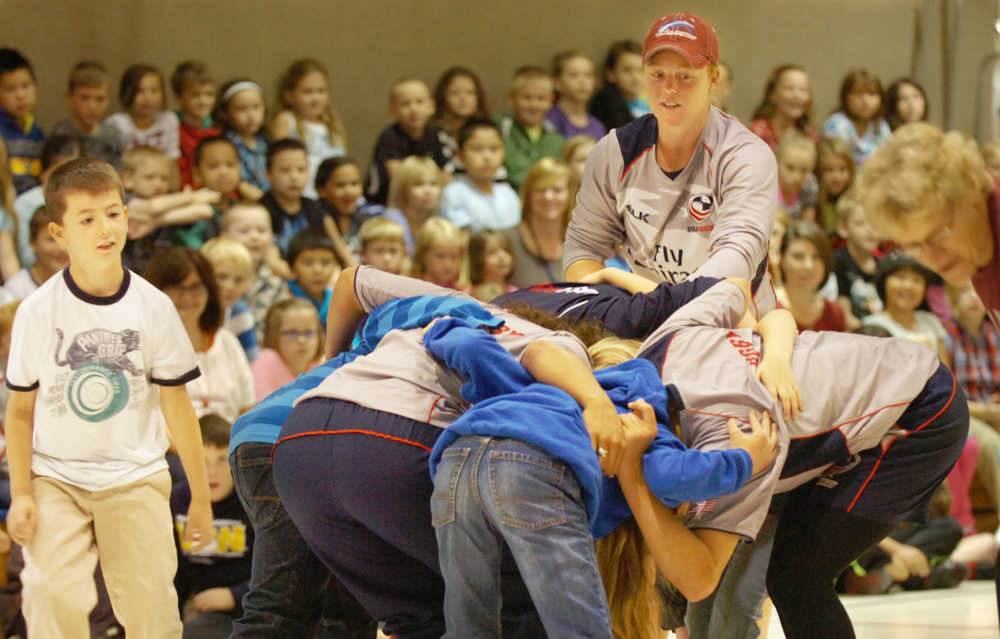Mountain View Elementary students learned some vocabulary words on Wednesday morning — “ruck,” “scrum,” “scrum-half,” “prop-forward,” and “grubber” were a few of them. Their teachers were four members of the U.S. Women’s Sevens Rugby Team, who demonstrated their sport in a presentation at Mountain View gymnasium.
Mountain View physical education teacher Mary Fischer is planning a rugby unit for her students, although unlike the rugby played by the Olympic team, it will be touch instead of tackle. Although rugby is less well-known in the United States than basketball or football, Olympic team member Alev Kelter said kids can learn it easily.
“Naturally, with every sport you have to learn the rules,” Kelter said. “Rugby has a lot of little rules, but the general aspect of rugby is very simple. … It’s got a lot of different skills that you can take from other sports — running forwards, passing backwards, and kicking.”
Many Mountain View students at Wednesday’s presentation seemed to have already picked up on the rules. When Kelter asked the students how many points are scored in a try — the rugby equivalent of a touchdown — several students shouted back the correct answer: five. When Kelter and her teammates Amelia “Meya” Bizer, Richelle Stephens, and Amy Naber demonstrated running and passing across the gym floor, many students already knew that in rugby, the ball cannot be thrown forward, but only passed backward and laterally.
Ben Mohr of the Alaska Rugby Foundation is accompanying the Olympic Women’s Sevens team on their promotional tour of Alaska. Mohr said Kelter, a native of Eagle River and one of two Alaskans on the team (the other, Lorrie Clifford, is also from Eagle River), had convinced her coach to bring the team for training at the Alaska Mountain Rugby grounds in Anchorage. While in Alaska, the team also decided to visit schools and go on outings that recently included fishing on the Kenai River and shooting at Kenai’s Snowshoe Gun Club on Tuesday.
For some of the team members, these experiences have colored the way they teach their sport. When Meya Bizer demonstrated the proper way to grip the rugby ball for a spin pass — with one hand near the ball’s upper point and one near the lower point — she compared it to holding a salmon.
“You have the gills, and the tail,” said Bizer. She added cautiously: “But I’ve only been fishing once, and that was yesterday.”
Kelter said members of the team had already visited around 30 schools in the Anchorage area. She added that Mountain View was embracing rugby more than some of these other schools.
“This school is a little bit ahead of the curve, because they have some rugby balls already in the gym,” Kelter said.
Sevens rugby — the variant played by the team visiting Alaska, with seven players on each side — will make its debut as an Olympic event in the 2016 Summer Olympics in Rio De Janeiro, Brazil, where it will be played alongside union rugby, which features 15 players on a side. Union Rugby was previously played in the 1924 Paris Olympics, but hasn’t appeared since. Mohr said rugby’s popularity in the United States tends to be cyclic.
“Right now, what’s growing is the popularity of youth rugby,” Mohr said. “It’s an extremely affordable sport. It only requires a mouthguard and cleats. … The barrier to entry is extremely low. And I think we’re going to see interest in the sport grow significantly. One, because it’s going to be in the Olympics. Two, because the record of safety in rugby, particularly in youth rugby where it’s only touch, is extremely high. Lower incidence of concussions and severe trauma than football or soccer.”
Kelter said youth rugby is a good game for schools.
“I think at the young age where you do touch rugby, it’s a game of tag really,” Kelter said. “You’ll teach them how to listen, how to be disciplined, how to communicate. You’ll teach them how to work together, and that’s extremely beneficial in a school setting.”
Reach Ben Boettger at ben.boettger@peninsulaclarion.com.

